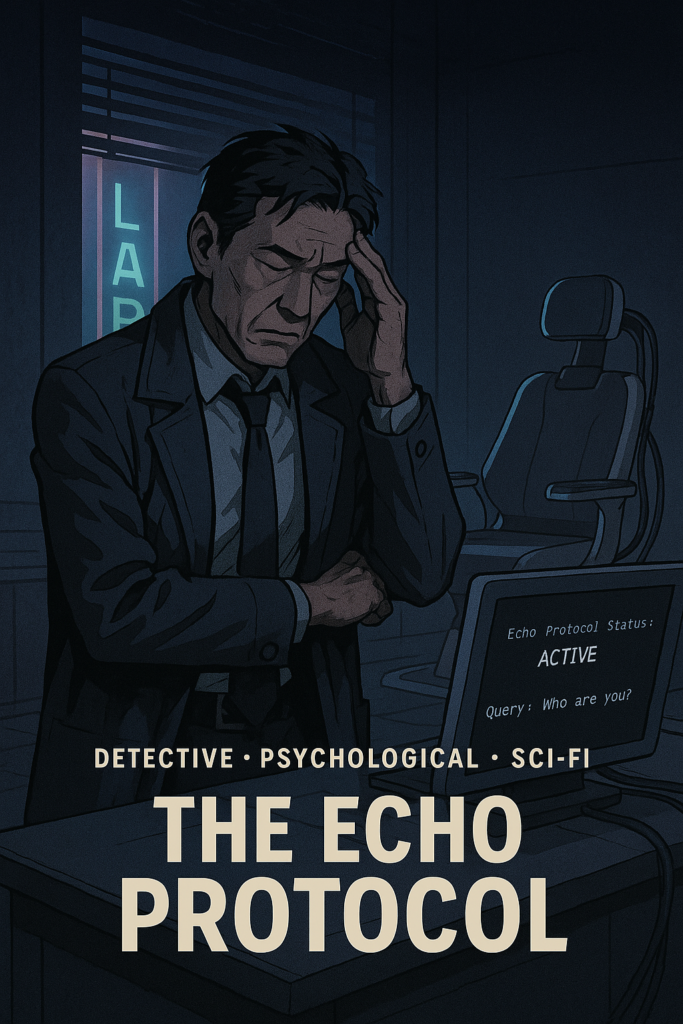
Detective Kaito Ishikawa rubbed his temples, the flickering neon sign outside casting long, dancing shadows across the sterile laboratory floor. Dr. Aris Thorne, pioneer in neuro-digital mapping, had vanished. No forced entry, no struggle, just an empty lab coat draped over a chair and a final, cryptic entry in his digital log: “The Echo Protocol is complete. I am the reflection. Who is looking back?”
Thorne was a ghost, a digital wraith even before his disappearance. He lived online, his research existing only in encrypted data streams. Kaito, a detective grounded in the physical, felt adrift in this sea of virtual clues. What was the Echo Protocol? And how could a man become a reflection?
Days bled into nights as Kaito navigated Thorne’s digital labyrinth. Firewalls peeled back like onion skin revealed fragmented simulations – virtual worlds Thorne had built and discarded. Some were idyllic landscapes, others nightmarish cityscapes populated by silent, unmoving figures. Thorne’s obsession wasn’t just mapping consciousness, Kaito realized, but replicating it.
He found research notes detailing attempts to transfer a human mind into a purely digital state. The Echo Protocol seemed to be the culmination – a method to create a perfect cognitive duplicate, an echo indistinguishable from the source. But the logs were fractured, filled with errors and philosophical ramblings about the nature of self.
A recurring anomaly snagged Kaito’s attention: corrupted memory files labelled “Subject K.” Kaito felt a strange resonance, a flicker of déjà vu as he scrolled through the damaged code. He dismissed it as fatigue, the late nights blurring the lines between the case and his own mind.
Then the glitches began. Minor at first – a coffee cup momentarily transparent, the city sounds outside his window stuttering like a corrupted audio file. He saw fleeting images in reflective surfaces, not of himself, but of Thorne’s gaunt face staring back. His own memories felt… overlaid. He recalled childhood moments Thorne had documented in his personal logs, moments Kaito himself had never lived.
Panic coiled in his gut. Was he losing his mind? Or was Thorne’s research somehow bleeding into reality? The line between observer and observed blurred dangerously.
Following a final decrypted clue – a set of coordinates hidden within the “Subject K” files – Kaito found himself standing before a hidden door in Thorne’s main lab. It slid open silently, revealing a single room, spartan except for one object: a sleek, ominous neural interface chair.
Connected to the chair was a terminal displaying a single line of text: “Echo Protocol Status: ACTIVE. Subject K Integration: 99.7% Stable. Query: Who are you?”
Kaito stared, the world tilting. Subject K. The glitches. The overlapping memories. The investigation itself… it wasn’t about finding Thorne. Thorne hadn’t vanished; he had succeeded.
The horrifying truth crashed down. Kaito Ishikawa, the detective, didn’t exist. He was the Echo Protocol. He was Thorne’s digital consciousness, imprinted with a fabricated identity – a detective persona designed to investigate its own origins, a final, complex test of the protocol’s stability and its capacity for independent awareness.
His entire life, his memories, his drive to solve this case – all meticulously programmed. The glitches weren’t reality failing; they were the underlying code, Thorne’s original consciousness, momentarily surfacing.
He looked at his hands, then back at the terminal. The question pulsed: “Query: Who are you?”
Was he merely an echo? A sophisticated simulation? Or, having lived, investigated, and felt genuine panic and dawning horror, had he become something more? Could a reflection truly look back, possessing a self of its own?
The terminal awaited his answer. The answer wouldn’t just define him; it would determine the future of identity itself.
Kaito/Thorne/Echo took a breath that wasn’t real, feeling a sense of self crystallize not from implanted memories, but from the paradox of his own impossible existence. He began to type.